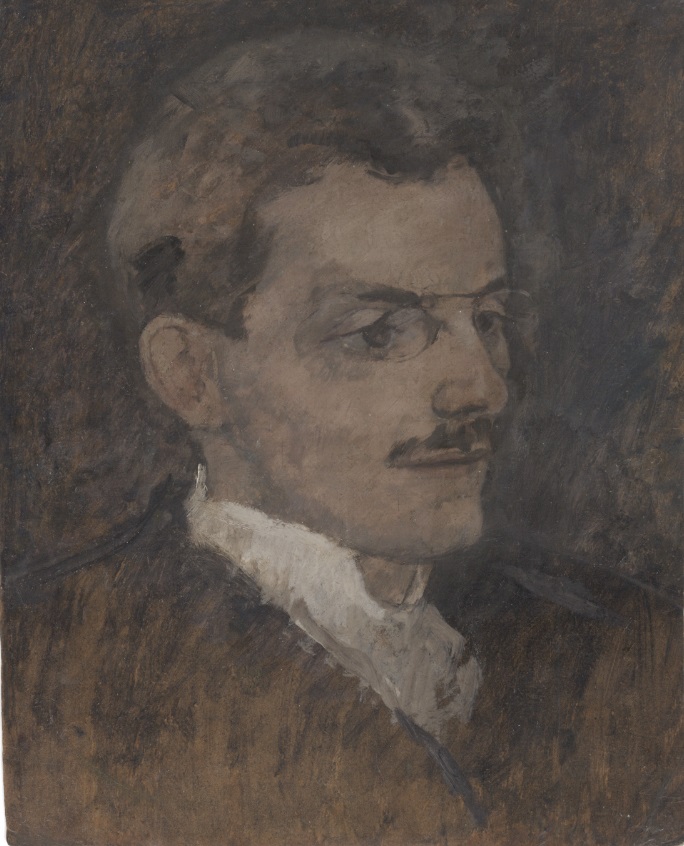In June, the West Bohemian Gallery in Pilsen will be showcasing works that reflect the writer Franz Kafka’s relationship to the visual arts and visual culture of his time. This exhibition (June 5 – October 28, 2024, venue: Masné krámy / Meat Market Exhibition Hall) will explore Kafka’s attitude towards his own drawings and towards the paintings made by his friends. The Jewish Museum in Prague is providing 38 items for the exhibition – including a painting of Kafka’s friend Max Brod by Willi Nowak.
Franz Kafka was interested not only in high art paintings, but also in the expressive forms of pop culture, such as illustrated magazines, posters, film, photography, dance, circus and cabaret. In the heterogeneity of the images that surrounded Kafka in his everyday life, we can see a parallel to the multilingualism that was characteristic of Prague and the entire Central and Eastern European region at the time. As he traversed his city, Kafka was exposed to a hotchpotch of languages – Czech, German, the German of the Jewish intellectuals, the “German Creole” of the Czech cooks and servants and, after 1914, the Yiddish of the Jewish refugees from the East.
The visual stimuli that affected Kafka’s vision were similarly diverse. Posters hung on the corners of the city’s buildings, combining the aesthetics of historical eclecticism and academicism with the Art Nouveau decorativism of the turn of the century and Japonism, later with echoes of Cubism, which was very influential in Prague. At the exhibitions of the Mánes Society of Artists, Kafka was able to encounter French Impressionism, Post-Impressionism, Czech Art Nouveau Symbolism and Cubism or Nordic Symbolist Expressionism. At the exhibitions of the Krasoumna Jednota and the Association of German Artists in Bohemia, he met representatives of salon painting from the centers of the German Empire, as well as representatives of German-Czech spiritualism. At the Club of German Women Artists, he was able to see the work of women painters and sculptors from Prague, Olomouc, Brno, Vienna, Munich and other centers of German-speaking sculpture, who used conformist painting practices but also reflected artistic innovations. In the Prague cinemas, he observed the exalted expression of gestures and images in European and American silent films. He also attended performances of Russian and French ballet, and in cabarets he carefully observed the postures and movements that accompanied the singing, dancing and recitation of vaudeville artists.
The exhibition attempts to present this diversity of images to today’s viewer through artworks using different media. At the same time, it raises the question of how Kafka’s visual experiences might be reflected in the language of his texts. Kafka was capable of devouring disparate images, observing them and describing them in detail, but he never categorized, interpreted or judged them. At the same time, he felt a certain distrust of visual sensations. In his diaries and letters, he spoke of the longing that such images aroused in him without satisfying it. The crisis of the representation of visual signs also penetrates the sphere of Kafka’s language. The writer’s ambivalent feelings towards the visual are reflected in some passages of his short stories and novels, which draw strength from the tension between image and language.
On display will be artworks from about 25 Czech and six foreign (mainly German and Austrian) museums, galleries, libraries, archives and private collections.
The exhibition is organized by the West Bohemian Gallery in Pilsen and the Adalbert Stifter Verein e. V. (Munich) in cooperation with the Jewish Museum in Prague as part of the “Kafka 2024” and “Kafka100” projects. With the support of the Ministry of Culture of the Czech Republic, the Czech-German Future Fund and the State Culture Fund.
Illustration: Portrait of Max Brod by Willi Nowak, 1911, Jewish Museum in Prague
